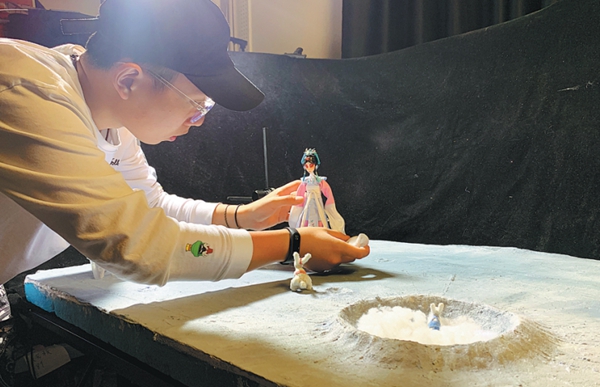

Students of a leading performing arts university get inspiration from both myth and technology, Cheng Yuezhu reports.
Young people can popularize traditional culture among their peers by making it both fun and educational. Students of new media art at the National Academy of Chinese Theater Arts showcased their works that use art and technology to promote traditional culture at an exhibition at Enjoy Art Museum in Beijing from May 26 to 30.
The title of the exhibition, Zuochang, is a term to describe traditional performing arts. It indicates going onstage to perform. This was apt for the occasion as the students were about to graduate and it recognized their achievement in bridging the traditional and the modern.
Of Chinese folk tales, the story of Chang'e, the moon deity, is one of the least obscure. According to one version of mythology, she, then-mortal, took her husband's elixir to prevent a villain from stealing it. She then flew to the moon and has been living there with a rabbit for company.
Despite being a fictional character, her moon-landing journey has been realized by China's lunar exploration project as the program is named after her. Last year, Chang'e 5 probe successfully landed on the moon. It returned to Earth with lunar samples.
Inspired by the ancient tale and China's lunar achievements, animation student Xu Yuanzhuo created a stop-motion animated short film that was shown at the exhibition.
"I remember staying up late to witness the moment when Chang'e 5 returned with lunar soil samples. The entire time I was so thrilled and inspired. It seems that for thousands of years, Chinese people had longed to go to the moon, and the dream had come true," Xu says.
His rendition extends the original story and takes a focus on life on the moon. In his imagination, the tale that Chang'e lives an immortal life on the moon is not as lonely or gloomy as one might think.
In his short film, Chang'e is accompanied by a rabbit family living in a lunar crater. One day when a bunny loses its way, the mother rabbit asks Chang'e for help to find the bunny and reunite the family.
Xu says he saw commonalities between the tale and the lunar exploration project.
"By protecting the elixir, Chang'e proved her devotion and valor that match the space exploration spirit of dedication and resolution. Dedication is the spirit of our times, and the transformation from a mortal to a deity symbolizes the drastic changes in modern China," he explains.
The National Academy of Chinese Theater Arts centers on Chinese opera. It boasts many outstanding productions of The Legend of White Snake, which was first adapted into a Peking Opera piece by Tian Han, the academy's first principal and a well-known playwright and author.